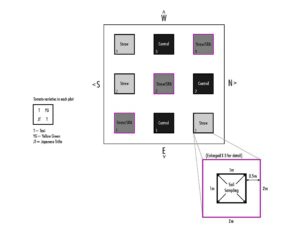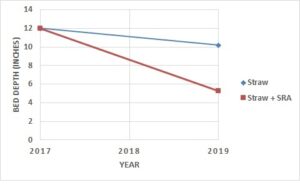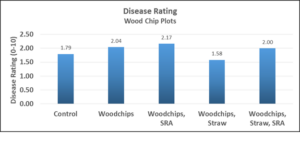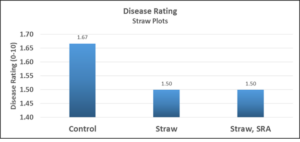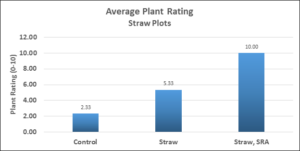Final report for FNC17-1070
Project Information
Field and Forest Products grows mushrooms commercially for farm markets and co-op accounts and has also been producing mushroom spawn and providing growing supplies to commercial cultivators and hobby growers for over 30 years. Field and Forest Products also supports its farmer customers by answering grower questions about how to grow specialty mushrooms profitably. The 41 acre farm grows and markets Shiitake and Wine cap as well as other specialty fungi, with special attention to polyculturing Wine cap and Almond Agaricus in the garden and high tunnel setting. Field and Forest Products Inc. is co-owned and operated by Mary Ellen Kozak and Joe Krawczyk. The couple are authors of several mushroom cultivation related publications, most notably, Growing Shiitake in a Continental Climate. Field and Forest Products recently teamed up with mycologist Lindsey Bender who specializes in soil microbial ecology, experimental design, and statistics. She comes from a diverse ecological background and has a strong interest in research and development focusing on sustainable practices and improving soil health.
The farm operates on a foundation of sustainable-focused practices. We strive to reuse and recycle as many resources as possible including, but not limited to: water, food scraps, paper materials, packaging materials, and other wastes generated by the business and farm operation. We participate in outdoor composting and indoor vermicomposting, utilize paper materials and other waste products as substrate for mushroom cultivation, heat our facility with sustainably harvested on-site firewood and exhausted shiitake logs, recycle gray water, reduce printing, and many more. The nature of fungi as environmental recyclers enhaces our abilities as a company to operate as sustainably as we can.
We proposed to evaluate an innovative, accelerated strategy for increasing soil organic matter and soil microbial activity by adding a decomposition specialist fungi to process raw organic amendments and to suppress plant disease while cultivating a cash crop of mushrooms. We sought to use this study as a platform to educate farmers on the importance of maintaining and improving soil health in sandy soil regions.
Our objectives were:
1) Test the ability of the wine cap fungus to speed up the process of increasing soil organic matter by adding organic material to soil surface.
2) Test the ability of the wine cap fungus to decrease disease severity, improve plant health, and increase tomato yields.
3) Evaluate the monetary value of adding a secondary mushroom crop to existing plant agriculture systems.
To address and test these objectives, we designed experimental plots and systematically collected data for statistical analysis. Based on our data, we were unable to provide statistically significant results to support objective 1 and our hypothesis that the Wine Cap mushroom would improve soil health within a short (two year) time frame. Objectives 2 and 3 were fulfilled. We found that although there was no statistically significant difference in disease presence in tomato plants grown with or without Wine Cap, the plants were healthier and yielded more tomatoes in the presence of the mushroom. Lastly, the mushrooms produced in the second year of this study resulted in a profit of $392.40. We conclude that the measurable benefits of the Wine Cap mushroom, ease of growing, and profit from mushroom sales is worth consideration to farmers.
The concept and results of this study were disseminated through a variety of means - lectures, workshops, farmer consultations, social media, research poster display, and a podcast episode. Over 1000 growers benefited from this project and can now adopt the recommendations concluded in this report.
We propose to evaluate an innovative, accelerated strategy for increasing soil organic matter and soil microbial activity by adding a decomposition specialist fungi to process raw organic amendments to suppress plant disease while cultivating a cash crop of mushrooms. This project is especially important because it provides a platform to educate farmers on the importance of maintaining and improving soil health in sandy soil regions.
Our objectives are:
1) Test the ability of the wine cap fungus to speed up the process of increasing soil organic matter by adding organic material to soil surface.
We are testing this through an experimental design which will allow us to measure changes in soil health parameters including microbial activity and soil organic matter. Our results will allow us to make statistical comparisons and draw conclusions based on changes in microbial activity and soil organic matter between treatments measured over the two year study period. We expect that treatment plots growing the wine cap fungus will have higher soil organic matter and microbial activity than control treatment plots with no wine cap fungus, with or without organic matter additions. Any increased changes can be attributed to the Wine Cap addition.
2) Test the ability of the wine cap fungus to decrease disease presence and severity in tomato plants.
Plants will be evaluated on a biweekly basis during the growing season for disease presence, disease severity, plant vigor, and tomato yield. We expect that tomato plants in treatment plots polycultured with the wine cap fungus will have decreased disease prevalence in comparison to control treatment plots with no wine cap fungus.
3) Evaluate the monetary value of adding a secondary mushroom crop to existing plant agriculture systems.
We will be harvesting mushrooms fruited from each of the experimental plots and record yield. Economic benefit from this secondary crop will be calculated based on the local market price of $12/lb of Wine Cap mushrooms.
Cooperators
- (Researcher)
Research
This project is designed to examine a unique, low cost method to increase soil organic matter (SOM) and decrease plant disease. SOM is created by microorganisms processing and transforming organic material additions to the soil. This project seeks to evaluate the efficacy of speeding up this process by cultivating an organic matter decomposer specialist and edible mushroom, the Wine Cap fungus alongside tomato plants.
We designed the experiment and treatment plots to reduce natural variation between plots while allowing for direct comparison. Treatment plots were replicated (3x).
Treatments:
- Control - nothing: These plots only contain 4 low disease resistant tomato plants and will yield information on baseline plant disease pressure to be compared to disease pressure in the wine cap treatment plots to determine the wine cap fungus' ability to suppress plant disease.
- Control - straw organic matter only: These plots contain 4 low disease resistant tomato plants as well as straw. No wine cap fungus. These beds will yield information on the underlying influence of adding organic matter and the activity of native microorganisms. We will compare these results to those of treatments with the Wine cap mushroom in order to measure the added benefits and ability of Wine Cap to speed up decomposition and increase soil organic matter.
- Control - woodchip organic matter only: These plots contain 4 low disease resistant tomato plants as well as woodchips. No wine cap fungus. These beds will yield information on the underlying influence of adding organic matter and the activity of native microorganisms. We will compare these results to those of treatments with the Wine cap mushroom in order to measure the added benefits and ability of Wine Cap to speed up decomposition and increase soil organic matter.
- Wine cap and straw: These plots contain 4 low disease resistant tomato plants as well as straw and the Wine Cap fungus. The data from these plots will allow us to quantify the ability of Wine Cap fungus to speed up decomposition and increase soil organic matter, while decreasing plant disease. We will also be able to measure mushroom yields and quantify the economic benefit of introducing mushroom cultivation to existing plant production systems. The results of these plots can also be compared to plots with Wine Cap grown on woodchips only or a combination of woodchips and straw.
- Wine cap and woodchips: These plots contain 4 low disease resistant tomato plants as well as woodchips and the Wine Cap fungus. The data from these plots will allow us to quantify the ability of Wine Cap fungus to speed up decomposition and increase soil organic matter, while decreasing plant disease. We will also be able to measure mushroom yields and quantify the economic benefit of introducing mushroom cultivation to existing plant production systems. The results of these plots can also be compared to plots with Wine Cap grown on straw only or a combination of woodchips and straw.
- Wine cap on woodchips and straw: These plots contain 4 low disease resistant tomato plants as well as woodchips and straw with the Wine Cap fungus. The data from these plots will allow us to quantify the ability of Wine Cap fungus to speed up decomposition and increase soil organic matter, while decreasing plant disease. We will also be able to measure mushroom yields and quantify the economic benefit of introducing mushroom cultivation to existing plant production systems. The results of these plots can also be compared to plots with Wine Cap grown on straw or woodchips only.
Soil samples were tested in all plots before the treatments were initiated and at the end of each project year. Soil tests were for pH, OM%, Phosphorus, potassium, magnesium, calcium, CEC, sulfur, boron, manganese, color and the Solvita test to measure microbial activity. Plants were assessed for disease presence, severity, and plant vigor. Tomatoes and mushrooms produced in each of the experimental plots were quantified. All data was collected and organised in Microsoft Excel. Data analysis was done using Systat and Excel.
Special note:
After our proposal was accepted and we were awarded the grant, we determined the best way to test our objectives in comparing straw beds verses woodchip beds would be to plant each of those at optimal times during year 1. For this reason, we created a spring 2017 planted research plot with controls and woodchip beds and a nearby fall 2017 planted research plot with straw only beds. Straw only beds are generally less successful when planted during the late spring/summer months and since our main objective is to evaluate the effects of the wine cap fungus on soil health and plant disease, we designed the experiment in order to optimize Wine Cap cultivation success based on years of experience.
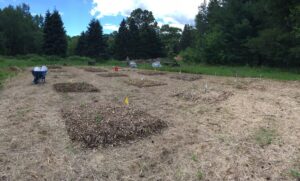

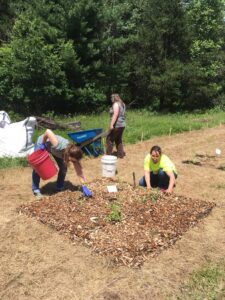
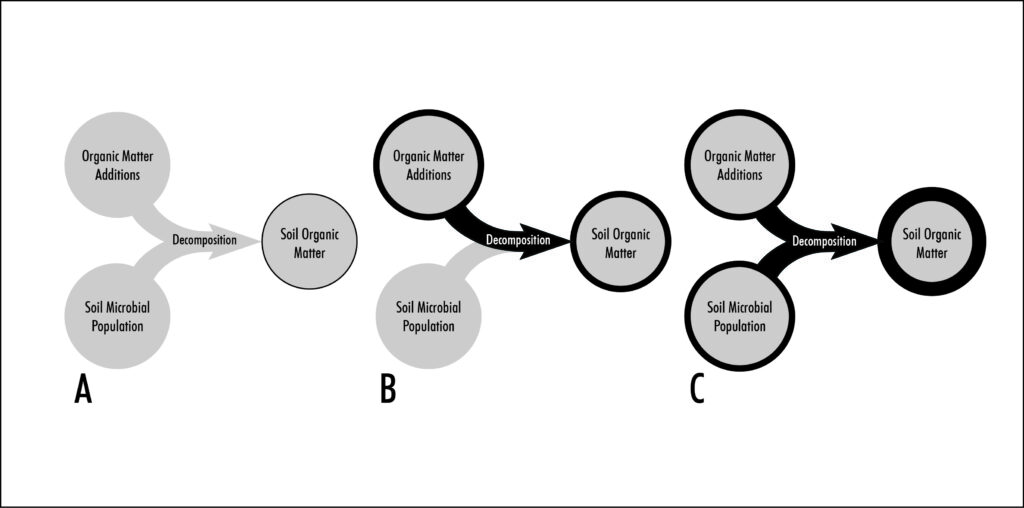
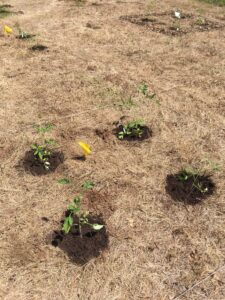
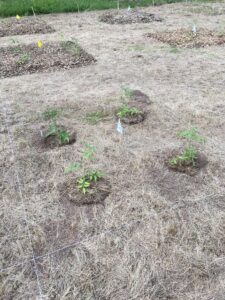
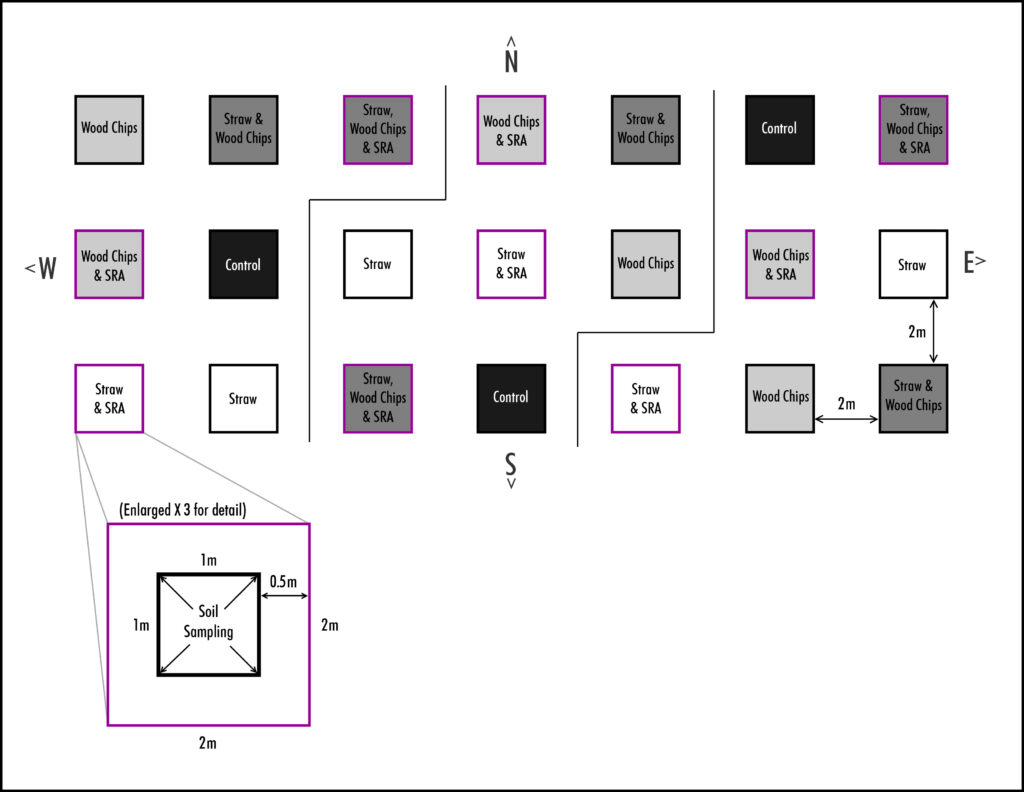


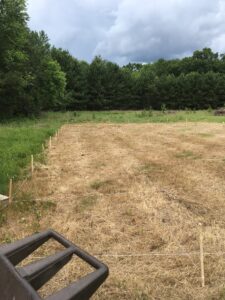
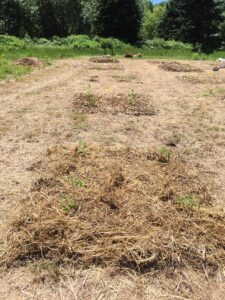
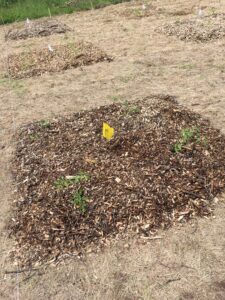
We proposed to evaluate an innovative, accelerated strategy for increasing soil organic matter and soil microbial activity by adding a decomposition specialist fungi to process raw organic amendments to suppress plant disease while cultivating a cash crop of mushrooms. This project is especially important because it provides a platform to educate farmers on the importance of maintaining and improving soil health in sandy soil regions. We had three objectives:
Objective 1) Test the ability of the wine cap fungus to speed up the process of increasing soil organic matter by adding organic material to soil surface.
We designed two experimental plots to assess the first objective – one plot evaluated the use of woodchips and the other evaluated the use of straw as an amendment (Figures 1a & 1b). Variable 1 that we tested was the type of amendment. There were four treatments of organic matter additions: 1) Control with no amendment 2) Straw 3) Woodchips 4) Straw and Woodchips. The second variable was the Wine Cap (Stropharia rugosa-annulata, “SRA”) mushroom. There were two treatments: 1) Control with no Wine Cap 2) Wine Cap. All treatments had 3 replicate plots.
We expected that treatment plots growing the wine cap fungus would have higher soil organic matter and microbial activity than control treatment plots with no wine cap fungus, with or without organic matter additions. Any increased changes can be attributed to the Wine Cap addition. Soil test results were inconclusive. Natural soil variation even amongst replicate plots reduced our ability to measure significant differences in soil organic matter over time and between treatments. In response to this, we decided to measure change in bed depth (inches of organic matter) over time and use that as a variable to measure Wine Cap’s ability to speed up the break down of organic matter. In the straw experimental plots, all plots started with 12” of straw. The presence of the Wine Cap mushroom significantly increased surface organic matter decomposition and the bed height decreased on average 6.7” over the period of 1.5 years. The plots without the Wine Cap mushroom only lost on average 1.8” of organic material (Figure 2). This loss could be attributed to natural settling and/or native microbial decomposition. Based on these results, we can conclude that the Wine Cap in this study was responsible for more rapid decomposition of straw than the native microorganisms. We continue to hypothesize that the presence of Wine Cap would eventually lead to faster increase in soil organic matter, however, those results could not be measured within the timeframe of this study.
Objective 2) Test the ability of the wine cap fungus to decrease disease presence and severity in tomato plants, improve plant health and tomato yield.
To test this, we planted low disease resistant heirloom tomato plants into our experimental plots. Those plants were evaluated on a biweekly basis during the growing season for disease presence, disease severity, plant vigor, and tomato yield. We expected that tomato plants in treatment plots with the Wine Cap fungus would have decreased disease prevalence in comparison to control treatment plots with no wine cap fungus.
Disease Suppression in Tomato Plants: Not significant
Disease severity was significantly higher in control plots in the straw experimental field indicating that the presence of straw mulch decreases disease (Figure 3b). Based on the data collected, there was no significant difference between mulched plots with or without the Wine Cap mushroom (Figures 3a & 3b). Despite our expectations, the presence of the Wine Cap mushroom did not decrease disease presence and severity in tomato plants.
Plant vigor and overall health: Significant
Overall plant health (visually rated biweekly on a scale from 0/dead – 10/healthiest) was lowest in control plots with no addition of mulch or Wine Cap mushroom (Figures 4a & 4b). The overall plant health was higher in treatments with a mulch layer of woodchips (5.00) and woodchip/straw (6.67) compared to the control (1.67). The plots with Wine Cap, woodchips and straw had the healthiest plants with an average rating of 8.33. These data indicate that the presence of mulch and Wine Cap increase overall plant health.
The tomato plants in the Straw beds showed a more drastic response to Wine Cap. Overall plant health was lowest in control plots (2.33), followed by straw mulch only plots (5.33), followed by perfectly healthy plants in plots with Wine Cap (10.00). These data indicate that the combination of straw mulch and Wine Cap mushroom improve the overall health of tomato plants (Figure 4b).
Tomato yield: Significant
Across all treatments, tomato plants yielded highest (lbs tomatoes) in plots with Wine Cap than without (Figures 5a & 5b). Plants in woodchip only plots yielded significantly fewer tomatoes than in woodchip plots inoculated with Wine Cap, 0.62lbs and 2.19lbs, respectively. The addition of straw with woodchips significantly impacted overall tomato yields to 0.60lbs/plot without, and 4.74lbs/plot with Wine Cap. Based on these data, we concluded that the presence of Wine Cap mushroom leads to increased tomato yields. This is likely in response to the increase in overall health of the tomato plant.
Objective 3) Evaluate the monetary value of adding a secondary mushroom crop to existing plant agriculture systems.
We harvested mushrooms fruited from each of the experimental plots and recorded yield. Economic benefit from this secondary crop was calculated based on the local market price of $12/lb of Wine Cap mushrooms. In addition, we assessed the ability of the Wine Cap mushroom to suppress weeds which results in less labor for the farmer and cost savings.
Wine Cap yield and potential revenue:
We harvested a total 40.2 lbs wine cap mushrooms from the three straw beds in 2018. Wine Cap mushrooms can be marketed directly to consumers for $12/lb for a total potential added revenue of $482.40 or $3.74/ft2. We used 6 straw bales ($3/bale) to construct these plots and 3 bags of Wine Cap spawn ($24/bag) for an overhead cost of $90 and a profit of $392.40. The added benefit of improved tomato yield in Wine Cap plots also increases farmer profits.
The straw plots produced more mushrooms that the woodchip experimental plots. This was likely due to bed depth and moisture. Woodchip beds were thinner and would require watering to increase bed moisture and mushroom yields. Straw beds were maintenance free and required no watering. We recommend straw beds because of the increased mushroom yields, faster decomposition, low cost and availability of straw, low maintenance requirements, and increased profitability.
Weed Suppression Results: Significant
The presence of a mulch layer (straw, woodchips, or both) significantly reduced weeds compared to control plots without mulch. Straw plots were virtually weed-free and maintained 94% weed suppression on average after a full growing year. Woodchip plots were slightly less effective at weed suppression than straw plots, showing an average of 71% weed suppression after a full year. This was likely due to the thinner layer of mulch material (3-4”) in woodchip beds than in thicker (6-10”) straw beds.
Discussion:
Overall, we can conclude that polyculturing Wine Cap mushrooms with tomato plants has many benefits including the addition of a profitable mushroom crop, healthier tomato plants, increased tomato yields, and nearly 100% weed suppression leading to increased profits and decreased labor for farmers. Despite seeing significant decomposition of organic material from the presence of the Wine Cap mushroom, we were unable to measure statistically significant changes in soil health over the short period of this study.
Figure 1a. Fall 2017 planted Straw experimental field.
Figure 1b. Spring 2017 planted woodchip experimental field.
Figure 2. Straw bed depth measured over time. All beds started with 12” straw. Beds with Wine Cap (SRA) showed more decomposition over the time of the study than the beds without Wine Cap.
Figure 3a. Average disease severity (rated 0 - 10) across woodchip treatment plots. No significant differences.
Figure 3b. Average disease severity (rated 0 - 10) across straw treatment plots. Control plots without straw measured highest indicating the presence of mulch significantly decreases disease. No difference was measured between plots with or without the Wine Cap mushroom.
Figure 4a. Average tomato plant health rating in woodchip field treatments.
Figure 4b. Average tomato plant health rating in straw field treatments. Plots with the Wine Cap mushroom had the healthiest plants.
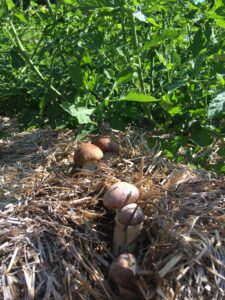
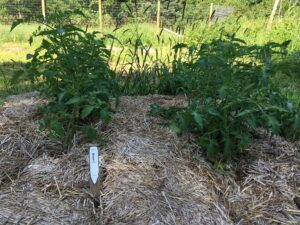
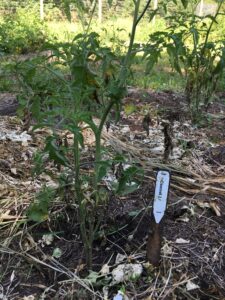
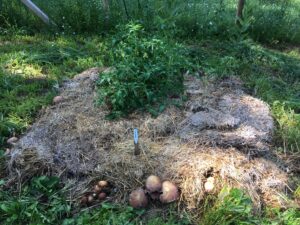
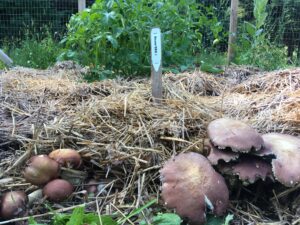
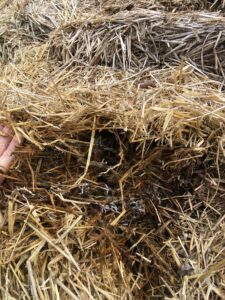
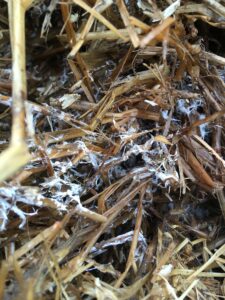

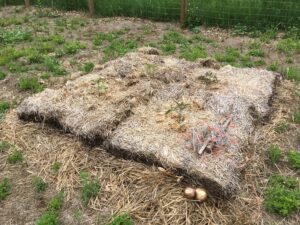
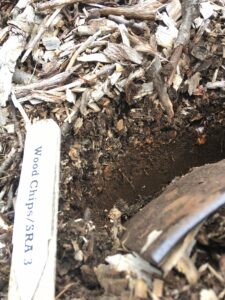
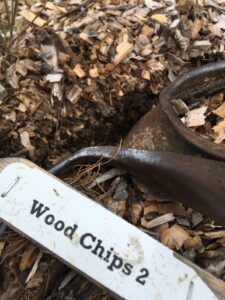
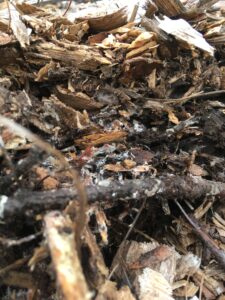
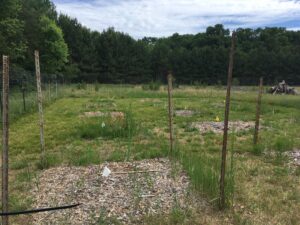
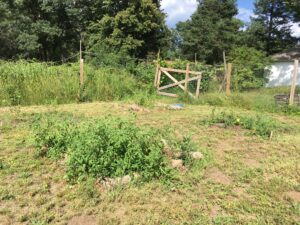

Educational & Outreach Activities
Participation summary:
I educate growers on mushroom cultivation through a variety of events including hands-on workshops, educational series, lectures, seminars, and podcast series. I introduce the topic at each event by discussing the benefits of growing edible fungi - including how Wine Cap can improve soil conditions and the research project completed with this grant. In total, the direct outreach of these events is over 1000 attendees including approximately 150 mushroom farmers, 175 master gardeners and 875 gardeners, growers, and members of the public. Field & Forest Products participates annually at the MOSES Organic Farming Conference and discussed this research with many of the attending farmers. Lastly, through Field and Forest Products' social media accounts and over the phone customer service, we have reached out to an extensive network of mushroom farmers in the NCR region to share the results of this project and will continue to do so in the future.
Below is a list of the events referenced above:
9/26/17 - Presentation at the Green Bay Botanical Gardens entitled "Mushrooms & Vegetables, Better Together!". Participants were several community members and a class of 20 students from a local school in the Sustainable Agriculture program at the Northeast Wisconsin Technical College. During the two-hour event, I discussed the research we are doing using cultivatable fungi to improve soil health, showed photos of our research beds, then led a demonstration where we created a wine cap bed in the Sustainable Agriculture garden. This bed is labeled and runs alongside a popular trail people use through the natural area. It will serve as an educational tool to visitors for several years.
Event details at: http://eventful.com/greenbay/events/mushrooms-and-vegetables-better-together-/E0-001-105810188-5
1/25/18 - Presentation to the Outagamie County Master Gardener's Association meeting at the Fox Valley Technical College Agriculture Center about the many benefits of polyculturing plants and fungi including improving soil health and reducing plant disease. "Adding gourmet and medicinal mushrooms to your garden". Approximately 75 master gardeners were in attendance. I discussed our research grant and explained the potential benefits this research will yield.
Event details at: https://www.ocmga.net/public-education/
2/9/18 at 3:00pm, Mendota Rooms 6/7 – presentation at the Madison Garden Expo 2018 entitled “Growing Mushrooms 101”. One hour presentation discussing the ease of growing mushrooms in polyculture with plants and ongoing research we are doing to evaluate the many benefits of growing plants and mushrooms together. I showed photos of our research plots and discussed preliminary results. This talk was advertised on the MGE event website and at the Field and Forest Products booth over the course of the event weekend. Attendance ~150 people.
Event details and abstract here: http://www.wigardenexpo.com/schedule#friday
2/11/18 at 11:45am, Mendota Rooms 6/7 – Presentation at the Madison Garden Expo 2018 entitled “Fungi: The Unseen Superhero”. I did a one hour presentation discussing the power and role of fungi as decomposers of this world to transform organic materials into resources available to plants. I discussed the SARE grant research and showed photos of our project. This talk was advertised on the MGE event website and at the Field and Forest Products booth over the course of the event weekend. Estimated attendance at the expo was ~15,000. Lecture attendance was ~150 people.
Event details and abstract here: http://www.wigardenexpo.com/seminars-sunday#sun & https://www.fieldforest.net/events.asp
2/22-2/24/18 – Field and Forest products had a booth at the MOSES Organic Farming Conference in La Crosse, WI. which allowed me to network and discuss our ongoing research with fellow researchers and farmers geared towards organic farming, sustainability, and alternative agriculture practices. This event is advertised on the MOSES OFC and Field and Forest Website. Estimated attendance at this event is ~3,500.
Event details here: https://mosesorganic.org/conference/ & https://www.fieldforest.net/events.asp
4/3-4/5/18 – Our Farms, Our Future conference in St. Louis, Missouri hosted by SARE/NCAT/ATTRA – Poster presentation entitled "Cultivating the Wine Cap mushroom while building soil health and suppressing plant disease - an innovative and economical approach to two common agricultural problems" on April 3rd, 2018. Beyond the poster presentation, I networked with other individuals at the event and discussed our ongoing SARE research. Estimated attendance at this event is unknown.
Event details here: https://www.sare.org/Events/Our-Farms-Our-Future-Conference/Posters
4/21/18 – All day workshop event at Field and Forest Products educating on the cultivation of edible fungi. Part of the event was a tour of our facility grounds including the SARE research plot to discuss ongoing projects. Attendance ~30 people.
Event details here: https://www.fieldforest.net/events.asp
5/19/18 – All day workshop event at Field and Forest Products educating on the cultivation of edible fungi. Part of the event was a tour of our facility grounds including the SARE research plot to discuss ongoing projects. Attendance ~30 people.
Event details here: https://www.fieldforest.net/events.asp
6/7/18 - Lecture given at the Egg Harbor Library (Door Co, WI) entitled "Growing gourmet and medicinal mushrooms". Attendance ~25 people.
Event details here: https://kresspavilion.org/event-thursday-june-7-growing-gourmet-and-medicinal-mushrooms-with-field-and-forest/
7/19/18 - Lecture given at The Farmory (Green Bay, WI) entitled "Growing gourmet and medicinal mushrooms". Attendance ~25 people.
Event details posted here: http://www.farmory.org/events/
8/25/18 - Lecture given at the All Things Fungi Festival (Woodruff, WI) entitled "Growing mushrooms at home". Attendance ~50 people.
Event details posted here: https://today.wisc.edu/events/view/122843
11/13/18 - Lecture given to Winnebago County (WI) Master Gardener's Association entitled "The benefits of growing gourmet and medicinal mushrooms". Attendance ~100 people.
Event details posted here: http://www.winnebagomastergardeners.org/Classes.html
11/26/18 - Class taught at the Lifelong Learning Institute at University of Wisconsin - Green Bay entitled "The benefits of growing gourmet mushrooms". Attendance ~25 people.
Course catalog posted here: https://www.uwgb.edu/lifelong-learning-institute/course-catalog/
11/30/18 - Podcast episode "Mushrooms and Mycology" on The Permaculture Podcast. This podcast is aired and available for the public. The release is announced through the website and on social media. Unknown listenership.
Available on iTunes and https://www.thepermaculturepodcast.com/2018/1838/
2/8/19 at 12:30pm – Minona/Wingra room - Presentation at the Madison Garden Expo 2019 entitled “The Benefits and Ease of Growing Mushrooms in the Garden”. I did a one hour presentation discussing polyculturing plants and mushrooms together. I discussed the SARE grant research and showed photos of our project. This talk was advertised on the MGE event website and at the Field and Forest Products booth over the course of the event weekend. Estimated attendance at the expo was ~13,000. Lecture attendance was ~100 people.
Event details and abstract here: https://www.wigardenexpo.com/schedule & https://www.fieldforest.net/events.asp
2/9/19 at 11:45am - Mendota 5 - Presentation at the Madison Garden Expo 2019 entitled "Mushroom Growing 101". I did a one hour presentation discussing the benefits of mushroom growing including the results of this project. This talk was advertised on the MGE event website and at the Field and Forest Products booth over the course of the event weekend. Estimated attendance at the expo was ~13,000. Lecture attendance was ~150 people.
Event details and abstract here: https://www.wigardenexpo.com/seminars-saturday#sat https://www.fieldforest.net/events.asp
2/16/19 at 2:00pm - Harmony Pizza, Appleton, WI. "Small Scale Organic Mushroom Growing" lecture. Presentation to local organic farmers on incorporating mushrooms into their crops. The event was advertised locally and through social media. Lecture attendance was ~40.
https://www.evensi.us/small-scale-mushroom-production-talk-harmony-pizza/290054515
https://www.facebook.com/events/285090605507809/
3/12/19 at 6:00pm - The Farmory, Green Bay, WI. "Mushroom Cultivation" lecture. Presentation to sustainable, local organic growers about mushroom cultivation and it's benefits including the SARE research project improving soil health. The event was advertised on the organization's website, FFP website, and social media. Attendance was ~40 people.
https://www.facebook.com/events/the-farmory-green-bay/mushroom-cultivation/934476736725448/
3/13/19 at 6:30pm - Oconto Falls Library, Oconto Falls, WI. "The Benefits of Growing Mushrooms" lecture. Educational series open to the public. The event was advertised on the organization's facebook page and FFP website. Attendance was ~20 people.
https://www.facebook.com/ocontofallslibrary/
5/11/19 from 9:00am-5:00pm - Field & Forest Products, Peshtigo, WI. "Planting a Mushroom Garden" Workshop. This on farm workshop was held at Field & Forest Products' farm. We spent the day educating on the benefits of growing mushrooms, touring the farm and our SARE project experimental plots, and doing some hands on planting of the Wine Cap mushroom. This event was advertised on social media and the FFP website. Attendance was 25.
https://www.fieldforest.net/events.asp
6/13/19 at 6:30pm - Oshkosh Garden Club meeting, Oshkosh, WI. "The benefits of growing mushrooms in your garden". Lecture given prior to garden club meeting. Open to the public. The event was advertised through the garden club, on their Facebook page and FFP website. Attendance was ~20 people.
https://www.facebook.com/events/evergreen-retirement-community/mushrooms/427617941334363/
Learning Outcomes
Implementing a large scale project such as this one takes a significant investment in time, focus, planning, and data collection. One of the advantages we've found with going through the process has been an enhanced sense of teamwork while networking, teaching, and collaborating on the project. Despite all the planning, we struggled with weather conditions (too cold and wet, then too hot and dry) impacting our crops. Overall, tomato and mushroom yield was lower in some plots than expected due to less optimal growing conditions. We adjusted our methods to include watering the crops as necessary. Through this experience, we learned that thicker mushroom beds held moisture better than thin mushroom beds (which significantly improved tomato and mushroom yields). For future farmer and ranchers, we would recommend planting beds thicker than 4" to improve results.
Furthermore, there was more natural soil variation even between replicates. This made statistical analysis of the soil test data difficult. Because of this, I decided to measure additional variables like bed depth to aid in quantifying the effects of Wine Cap on organic matter decomposition. For future researchers investigating soil health, I would recommend fewer treatments and more replicates in order to gather more reliable data.
Project Outcomes
Soil heterogeneity throughout our experimental plot resulted in high natural variation in our soil test results. We foresaw this being problematic and designed the soil sampling protocol to include a soil sample buffer zone, sampling many soil cores/plot, homogenizing those samples, and sending off a subsample from each plot for analysis. Unfortunately, even 3 replicates per experimental treatment seemed insufficient to measure statistically significant changes in soil variables. I would recommend fewer treatments and more replicates.
Secondly, the woodchip plots were slower to colonize, slower to degrade, and more prone to drying out (because of the shallow mushroom bed). Straw plots were thicker, more productive, and required a lot less maintenance. The straw colonizes quickly and is the better candidate (over woodchips) for future projects aiming to measure soil improvement using Wine Cap mushrooms.
